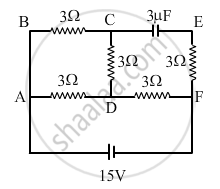Advertisements
Advertisements
प्रश्न
A wire of resistance 9 ohm having length 30 cm is tripled on itself. What is its new resistance?
उत्तर
Resistance (R) = 9 ohm
Length l = 30 cm
New Length (l) = 30 cm = `l/3` = 10 cm
New area an = 3a
`R = ρ 1/a`
Initial resistance `9 = ρ 30/a` ...(i)
New resistance `R_n = ρ 10/(3a)` ...(ii)
On dividing eqn (ii) by (i), we get,
`R_n/9 = (ρ 10/(3a))/(ρ 30/a)`
`R_n /9 = 10/90`
`R_n /9 = 1/9`
`R_n /1 = 9/9`
Rn = 1 Ω
Hence, The new resistance = 1 ohm.
APPEARS IN
संबंधित प्रश्न
If the potential difference across the ends of a conductor is 220 V and the resistance of the conductor is 44 Ω (ohm), then the current flowing through is _________.
- 0.2 A
- 0.5 A
- 2 A
- 5 A
Ohm's law gives a relationship between:
(a) current and resistance
(b) resistance and potential difference
(c) potential difference and electric charge
(d) current and potential difference
In the circuit shown in the figure, find the total resistance of the circuit and the current in the arm AD.

Tick(✓) the correct choice in the following:
Ohm's law is applicable to
The ratio of the potential difference to the current is known as ________.
Explain the equivalent resistance of a series resistor network.
Assertion: The statement of Ohm’s law is K = IR.
Reason: V = IR is the equation which defines resistance.
A metal rod of length 10 cm and a rectangular cross-section of 1 cm × `1/2` cm is connected to a battery across opposite faces. The resistance will be ______.
The resistance of a resistor is reduced to half of its initial value. If other parameters of the electrical circuit remain unaltered, the amount of heat produced in the resistor will become ______.
A current of 0.8 A flows in a conductor of 40 Ω for 1 minute. The heat produced in the conductor will be ______.
